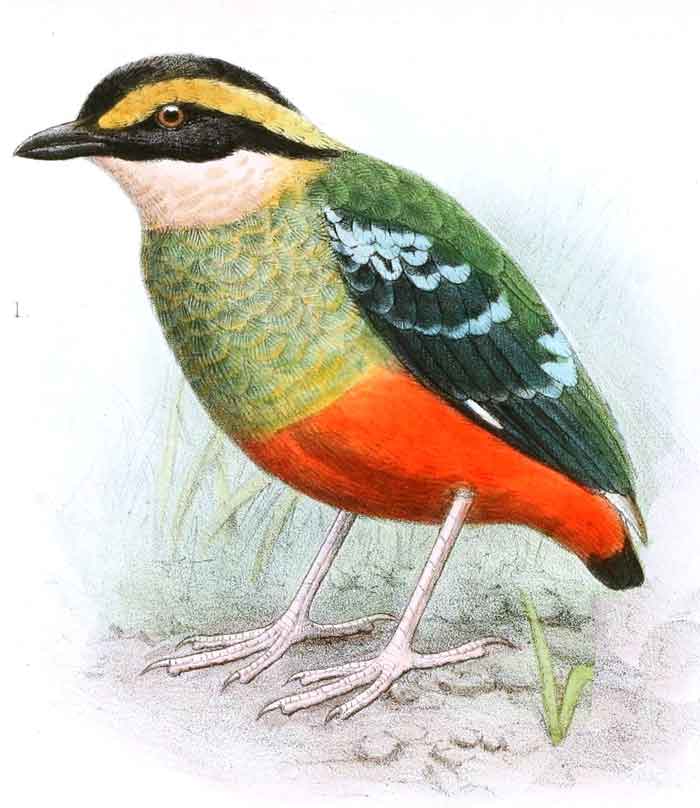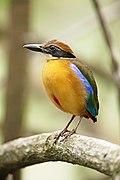Superregnum: Eukaryota
Regnum: Animalia
Subregnum: Eumetazoa
Cladus: Bilateria
Cladus: Nephrozoa
Superphylum: Deuterostomia
Phylum: Chordata
Cladus: Craniata
Subphylum: Vertebrata
Infraphylum: Gnathostomata
Superclassis: Tetrapoda
Cladus: Reptiliomorpha
Cladus: Amniota
Classis: Reptilia
Cladus: Eureptilia
Cladus: Romeriida
Subclassis: Diapsida
Cladus: Sauria
Infraclassis: Archosauromorpha
Cladus: Crurotarsi
Divisio: Archosauria
Subsectio: Ornithodira
Subtaxon: Dinosauromorpha
Cladus: Dinosauria
Ordo: Saurischia
Cladus: Theropoda
Cladus: Neotheropoda
Infraclassis: Aves
Ordo: Passeriformes
Subordo: Tyranni
Infraordo: Eurylaimides
Superfamilia: Pittoidea
Familia: Pittidae
Genus: Pitta
Species: P. anerythra – P. angolensis – P. brachyura – P. concinna – P. elegans – P. iris – P. maxima – P. megarhyncha – P. moluccensi – P. nympha – P. reichenowi – P. sordida – P. steerii – P. superba – P. versicolor – P. vigorsii
Name
Pitta Vieillot, 1816
Typus
Corvus brachyurus Linnaeus, 1766, = Pitta brachyura

Pitta reichenowi
References
Analyse d'une nouvelle ornithologie élémentaire: 42.
IOC vs, 11.1
Vernacular names
Deutsch: Pittas
English: Pitta
français: Brève
hrvatski: Pite
polski: Kurtaczki
ไทย: นกแต้วแร้ว
中文: 八色鸫科

Pitta angolensis

Pitta brachyura

Pitta concinna

Pitta maxima

Pitta megarhyncha

Pitta moluccensis

Pitta nympha

Pitta reichenowi

Pitta sordida

Pitta steerii

Pitta vigorsii
Pitta is a genus of birds in the Pittidae, or pitta family. They are secretive, brightly coloured birds that forage on the forest floor. They are long-legged and short-tailed with rounded wings.[2] They all have green on their upperparts with blue wing-patches. Many have dark heads.[3] Nest construction, incubation and rearing of nestlings is performed by both parents.[4] Incubation is completed in some 17 days, and the nestlings are altricial and nidicolous.[4] Some species are migratory.[3]
The antpittas, a Neotropical bird family of some 50 species, resemble the pittas in their hopping gait, furtive behaviour, long legs and short tails.
Taxonomy
The genus Pitta was erected by the French ornithologist Louis Pierre Vieillot in 1816.[5] In 1855 the English ornithologist George Robert Gray designated the type species as Corvus triostegus Sparrman. This is a junior synonym of Corvus brachyura Linnaeus, the Indian pitta.[6][7] The word Pitta is from the Telugu language and means "pretty", "bauble" or "pet".[8]
The genus contains 20 species, distributed from Africa, through southern, eastern and south-eastern Asia, to New Guinea, the Solomon Islands and Australia.[9] It was formerly the sole genus in the family and contained 31 species.[2] However, following a 2006 study, some of the species were split off into two resurrected genera, Erythropitta and Hydrornis, though all members of the family continue to be known as "pittas".[3]
Species
The genus contains 20 species:[9]
| Image | Scientific name | Common Name | Distribution |
|---|---|---|---|
 |
Pitta angolensis | African pitta | tropical and subtropical Africa |
| Pitta reichenowi | Green-breasted pitta | tropical Africa | |
 |
Pitta brachyura | Indian pitta | Indian subcontinent |
 |
Pitta moluccensis | Blue-winged pitta | Australia and Southeast Asia |
 |
Pitta megarhyncha | Mangrove pitta | eastern India to western Southeast Asia |
 |
Pitta sordida | Western hooded pitta | mainland and maritime Southeast Asia |
| Pitta abbotti | Nicobar hooded pitta | Nicobar Islands | |
| Pitta forsteni | Minahasa hooded pitta | north Sulawesi | |
 |
Pitta novaeguineae | Eastern hooded pitta | New Guinea |
| Pitta rosenbergii | Biak hooded pitta | Biak (Cenderawasih Bay islands, northwest New Guinea) | |
 |
Pitta nympha | Fairy pitta | East Asia |
 |
Pitta versicolor | Noisy pitta | eastern Australia and southern New Guinea |
 |
Pitta maxima | Ivory-breasted pitta | North Maluku |
 |
Pitta concinna | Ornate pitta | Lesser Sunda Islands |
 |
Pitta elegans | Elegant pitta | Lesser Sunda Islands |
| Pitta vigorsii | Banda Sea pitta | Maluku Islands | |
| Pitta anerythra | Black-faced pitta | western Melanesia | |
 |
Pitta steerii | Azure-breasted pitta | Philippines |
| Pitta superba | Superb pitta | Manus Island (north of Papua New Guinea) | |
 |
Pitta iris | Rainbow pitta | northern Australia |
References
"Pittidae". aviansystematics.org. The Trust for Avian Systematics. Retrieved 2023-07-24.
Zimmerman, Dale A.; et al. (1999). Birds of Kenya and Northern Tanzania. Princeton University Press. p. 495. ISBN 0691010226.
Irestedt, M.; Ohlson, J.I.; Zuccon, D.; Källersjö, M.; Ericson, P.G.P. (2006). "Nuclear DNA from old collections of avian study skins reveals the evolutionary history of the Old World suboscines (Aves: Passeriformes)" (PDF). Zoologica Scripta. 35 (6): 567–580. doi:10.1111/j.1463-6409.2006.00249.x. S2CID 84788609.
Tarboton, Warwick (2001). A Guide to the Nests and Eggs of Southern African Birds. Cape Town: Struik. p. 141. ISBN 1-86872-616-9.
Vieillot, Louis Pierre (1816). Analyse d'une Nouvelle Ornithologie Élémentaire (in French). Paris: Deterville/self. p. 42, Num. 137.
Gray, George Robert (1855). Catalogue of the genera and subgenera of birds contained in the British Museum. London: British Museum. p. 43.
Traylor, Melvin A. Jr, ed. (1979). Check-list of Birds of the World. Vol. 8. Cambridge, Massachusetts: Museum of Comparative Zoology. p. 310.
Jobling, J.A. (2019). del Hoyo, J.; Elliott, A.; Sargatal, J.; Christie, D.A.; de Juana, E. (eds.). "Key to Scientific Names in Ornithology". Handbook of the Birds of the World Alive. Lynx Edicions. Retrieved 5 January 2019.
Gill, Frank; Donsker, David; Rasmussen, Pamela, eds. (December 2023). "NZ wrens, broadbills & pittas". IOC World Bird List Version 14.1. International Ornithologists' Union. Retrieved 10 January 2024.
Retrieved from "http://en.wikipedia.org/"
All text is available under the terms of the GNU Free Documentation License

